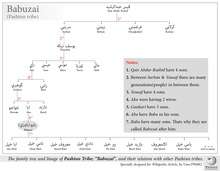Babuzai (Pashtun tribe)
Babuzai (also spelled: Babozai)(Pashto: بابوزي) is a Pashtun tribe mostly living in District Swat, Shangla and in District Mardan.

History
Babuzai is named after Babu (Often called: Baizai). There is a tradition among Pashtuns that they name the tribe after the name of that person from whom the clan or tribe has been initiated, the descendant are named after their first ancestor.[1] for instance, Babu is the name of a person, his descendant until now are called Babuzai.
The history of Pashtuns, which starts from talut, we know about the history of clans of Pashtuns tribes after Qais Abdur Rashid very well.[2][3]
Qais had four sons viz, Sarbani (سربڼي), Bettani (بېټني), Ghurghakhti (غرغښتي) and Karlani (کرلاڼي).[4]
The largest of the Pashtuns tribe is Surban, which have approximately 150 sub branches.[5]
Sarbanr have Yusufzai in his family tree. Yusufzai tribe was because of a Pashtun named Yousaf. Yousaf have five sons. Named:
- Esa
- Musa
- Torya
- Mali
- Aku
Aku have then 2 wives. Named: Gauhari & Rani. Gauhari have three sons named:
- Khwaja
- Bazid
- Aba
Aba had a son named babu (or Bauzi or Baizi), The descendant of babu and their descendant further forming a tribe were called Babuzai. Babuzai also have sub branches which are:.[6]
- Aba Khel
- Bami Khel
- Maruf Khel [7]
- Barat Khel
Aka Maruf confederacy include:[8] Haqdad Khel, Mazid Khel etc.
Bami Khel confederacy include:[9] Musa Khel, Burhan Khel, Mir Khel, Usman Khel, Langar Khel, Bibal Khel, Fateh Khan Khel, Dawlat Khel, Esa Khel etc.
Geography
They are mostly living in District Swat, Tehsil Puran and Ghurband of Distt Shangla & in District Mardan. Mardan have one town named Babozai. Swat have Tehsil named Babuzai. This is the reason because Pashtun tribe Babuzai people are living.
See also
- Union Council Babozai in Mardan
- Tehsil Babuzai in Swat
- Pashtun tribes
- Pashtun people
- Khalil (Pashtun tribe)
- Qais Abdur Rashid
References
- ↑ Glatzer, Bernt (2002). "The Pashtun Tribal System" (PDF). New Delhi: Concept Publishers. Retrieved 25 January 2015.
- ↑ Dawn, The cradle of Pathan culture, by Alauddin Masood, 4 April 2004.
- ↑ Niamatullah's history of the Afghans, Volume 1, Niʻmat Allāh, Nirod Bhusan Roy, Santiniketan Press, 1958, pg. 5.
- ↑ Coyle, Dennis Walter (August 2014). "Placing Wardak among Pashto varieties" (PDF). University of North Dakota:UND. Retrieved 26 December 2014.
- ↑ http://en.pashtunfoundation.org/bodytext.php?request=66
- ↑ MJ Siyal, Da Pokhtano Qabilo Shajarey, Published: 1986, P:85
- ↑ Yad Latif, Pukhtana Qabily Opejanai, p:16,18,49
- ↑ Yad Latif, Pukhtana Qabily Opejanai, p:16,18
- ↑ Yad Latif, Pukhtana Qabily Opejanai, p:49
Further reading
- Ewans Martin, (2002) Afghanistan: a short history of its people and politics: Publisher Perennial
- Romano, Amy (2003). A Historical Atlas of Afghanistan. The Rosen Publishing Group. p. 28. ISBN 0-8239-3863-8. Retrieved 2010-10-17.
- Khan, Roshan (1986). Yūsufzaʼī qaum kī sarguzasht. Karachi: Roshan Khan and Company.
- Khan, Roshan (1983). Malika-e Swat, 1st Edition, 1983: Roshan Khan and Company.
- Tawarikh-e Hafiz Rehmat Khani, 3rd Edition, 1977, Peshawar Pushtu Academy, Peshawar University.
- Afghano ki Nasli Tarikh, 1st Edition, 1981, Karachi Roshan Khan and Company.
- Baba-ye Qaum Sheikhmali (RA), 1st Edition, 1985, Roshan Khan and Company, Phool Chowk, Karachi, Pakistan.
- Haravi Nimat Allah, History of the Afghans, Translated: S. M. Imamuddin, Dhaka, 1960